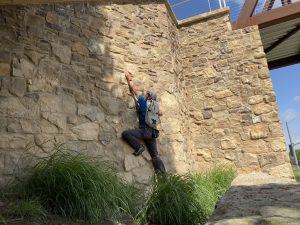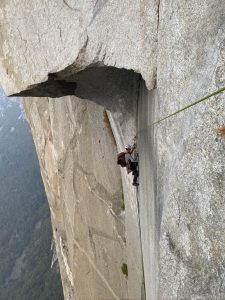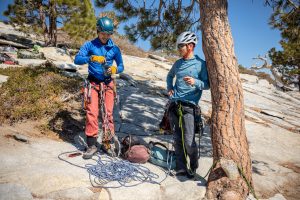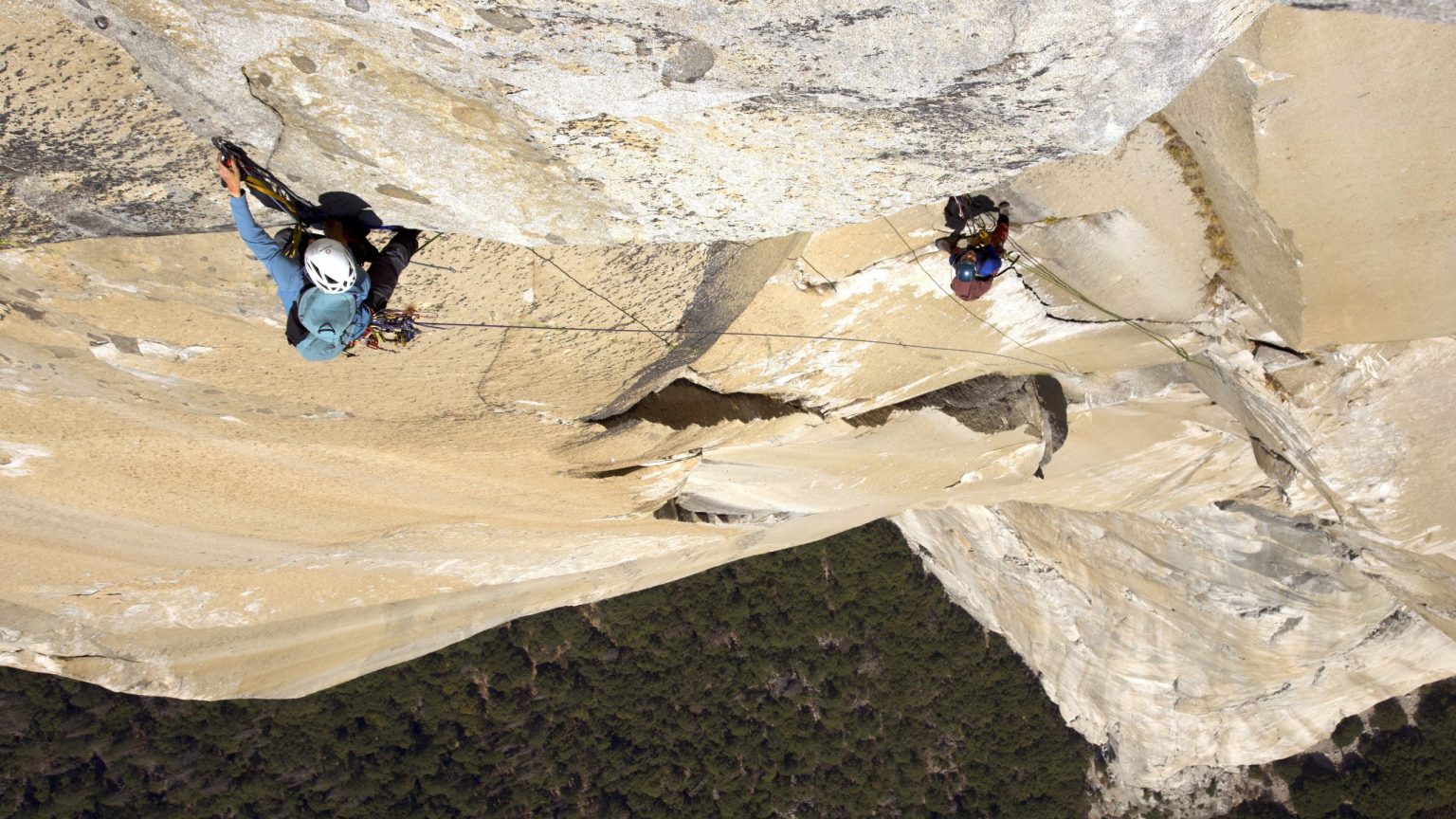Our Nose in a Day project wasn’t supposed to take so long. COVID closures, issues with training, the California wildfires—nothing went exactly as planned. But none of that mattered when we started up the route at 6:15 p.m. on October 17, 2020. There would be no surprises on the pitches to come. We knew the moves, had our gear dialed, already knew where and when we would drink and eat. We were prepared for the way the light from our headlamps would erase the granite features, as if the walls were no longer three-dimensional objects. All we had to do was climb.
It was seventeen months from the time my climbing partner, Ye, and I began to dream about doing the Nose in a Day to the moment we topped out. We first climbed the Yosemite classic in June 2019. At the top of Dolt Tower, we came across a bottle of water labeled “NIAD WATER—DON’T DRINK.” I remember laughing. There we were struggling to make it up in three and a half days. I couldn’t even imagine how people could do it in a day.
But it seemed like a fun goal, and also a good fit for my busy lifestyle. I’m married with a three-year-old daughter and I work full-time leading an entrepreneurial company, so it’s pretty challenging for me to carve out four days for a traditional big wall–style ascent. Yosemite is only a seven-hour drive from where I live in Southern California, and the NIAD would take no more than 24 hours. It was possible, at least logistically. I was motivated to make it happen.

Ye and I thought we would be ready by fall 2019, but my hectic schedule caught up to me. I was training in the morning before work, getting to bed around midnight after communicating with people overseas for business, and then waking up early on the weekends to drive to the Valley or get an alpine start. The accumulated fatigue dragged my body down to the point where it felt as if I had an infection. I had no power. My heart rate would spike upward, even in a mild training session. Rather than push through, I decided to give myself a break. (Ye also had to press pause on his climbing at the end of 2019. Previously a full-time PhD student in Salt Lake City, he spent the fall looking for jobs post-graduation. Luckily he ended up in LA.)
After taking almost a full month of rest, I began training again with Uphill Athlete coach Mark Postle. On January 10, 2020, Ye and I did our first multipitch climb together since fall—Epinephrine in Red Rocks, outside Las Vegas. We practiced short-fixing, a technique we would use for the Nose in a Day and one I had learned during my month off. It felt amazing to be back out with Ye on real rock, placing gear far above the ground and enjoying the views that come with exposure. I have always loved the freedom of trad climbing.
Unfortunately, my Epinephrine high didn’t last. The climb had followed a few busy meeting days in Vegas with a lot of handshakes, so I wasn’t surprised when I got sick again right after the trip. Was it COVID? Just the flu? Whatever it was, it laid me out for two weeks.
Finally recovered and with my strength coming back, I went to Zion with Ye at the beginning of February to climb Moonlight Buttress. Then in mid-February, we made it back to the Valley and climbed all the way to pitch 16 on the Nose, to Eagle Ledge. It was a pretty fast ascent. We were feeling ready for the NIAD.
As familiar as I was with the first half of the route, I still didn’t have a great sense for the upper pitches and how long they would take us. With that in mind, I was fortunate to team up with Hans Florine for a day in early March. He climbed 22 pitches with me jugging up after him, then we swapped leads and I led from the Pancake Flake to partway through Changing Corners to get a feel for how that section would go. Then Hans brought us to the top. Technically that was the Nose in a Day right there, but I don’t count it as more than a training lap. Climbing with Hans is almost like cheating—he can take anybody up there! But I felt good. I felt strong.

I told Ye to give me two weeks to recover, then we would give the NIAD a shot. Little did we know that Hans and I had made the last ascent of the Nose pre-pandemic. The same afternoon we topped out, a big storm hit Yosemite, shutting down the climbing. By the time the storm wound down, almost two weeks later, Yosemite had shut down completely due to COVID restrictions. Like everyone, Ye and I had no idea how long the closures would last.
With the gyms and climbing areas suddenly off-limits, I was desperate to keep training. I did endurance traversing underneath a nearby bridge (which I’m sure looked weird to anyone who saw me). Mark programmed strength training and low-intensity hangboarding sessions I could do at home. Instead of working through sets of short, challenging holds, I would hang off the bigger grips for longer intervals. I killed time by watching the whole Reel Rock series from beginning to end.
The gym opened for three weeks, then the second wave kicked in and it closed again. We wondered if it would stay in business. Longtime climbing partners started to say good-bye to each other: “It was fun while it lasted.”
By early summer, I realized that I would need to fight if I wanted to do the Nose in a Day in the fall. I needed to start climbing again, but I didn’t want to partner with anyone because of COVID. So I did two days where I went to Tahquitz Rocks and rope-soloed some 5.9 multipitch routes. Doing all the work by myself was excellent aerobic training.
Then summer kicked in and I switched my focus to the High Sierra. I took several trips there, either running 20-plus miles or, if I had a partner, doing a fast approach to an easy technical climb. It wasn’t typical rock climbing endurance training, but it made for a solid base period. Moving fast at 14,000 feet was helpful for getting me used to the mountain environment.
On one of those weekends I ran up and down Mount Whitney in six and a half hours. On another I climbed Mithral Dihedral, a classic route on Mount Russell (next to Whitney), with a new partner. We wore masks when we were together at the belay stations, then took them off once we were socially distanced again because we needed to breathe in the thin air. It was the first 5.10 climbing I’d done in four months. The tips of my toes hurt from standing on tiny edges.

Ye and I began partnering up again, and we got back on the Nose on August 29. We left the LA area early that morning, napped for a couple hours when we got to the Valley, then started climbing around 7 p.m. This was our first experience climbing through the night, which we planned to do for the NIAD to avoid having to pass parties on the wall. We did 14 pitches and felt crushed, mentally and physically. The cracks were easy to navigate by headlamp, but it was difficult to make out handholds and footholds while doing face moves. We rehearsed moves and memorized key features. Absolutely exhausted, we rappelled and then dozed for another couple hours before heading back to LA, alternating driving and napping. We needed to get home in time to catch up on work.
On September 6, one day after Ye and I got in a bunch of pitches at Tahquitz, 2020 threw another surprise our way. Massive, out-of-control wildfires closed Yosemite again. Smoke spread across the West Coast. Struggling to find somewhere—anywhere—to climb, we ended up at Joshua Tree on a 95-degree day. We set up top ropes on a couple north-facing walls and rope-soloed 73 pitches between us.
Yosemite was still smoky when it reopened three weeks later. Thrilled to be back on the Nose, Ye and I blasted through the Great Roof in 12 and a half hours. That clinched it: we would go for the NIAD in three weeks. We recruited friends to take photos and meet us on top with approach shoes and food and water. After months of uncertainty, it was feeling real.
But I got too excited after that final training session in the Valley. Back at the gym two days later, I climbed really well. I returned the next morning, without much sleep but still expecting to feel just as good. Instead, it was like the previous fall: I felt absolutely done, like I had no performance at all. I left after half an hour and went back to bed. Wondering if I might have COVID, I got a test. It came back negative. Meanwhile, Mark recommended against doing another big weekend training day.
“The potential upside is small, and the potential downside is big,” he told me.
I took his advice and stayed home. By the Sunday before the actual climb, I felt like I was getting back to almost 100 percent. I went to the gym on Monday and did a short run on Tuesday. It was the perfect taper—exactly what my body needed.
One final last-minute snag waited for us at the end of the week when I couldn’t get a park entry ticket for the Saturday of our climb. There I was, poised to claim one the minute they were released online, but they were snapped up in seconds. I kept hitting refresh—nothing. After we’d exhausted plans B, C, and D, Hans came to our rescue by offering to put us up at his Airbnb inside the park. Thanks to him, the final piece had fallen into place—just barely.
With our gear pared down to no more and no less than we would need, Ye and I left the ground, prepared to move through the night. Initially, I didn’t feel as strong as I had during our final training session in the Valley. Moves that had seemed easy then were giving me trouble. But my body warmed up after five pitches of leading and I began to flow with the familiarity of the route. By that point I had climbed more than 150 pitches on the Nose.
We French-freed as much as we could and used aiders only where we had to, including on the Jardine Traverse, the Lynn Hill Traverse, and the Great Roof. We got past the Great Roof—two-thirds of the way up—in just nine and a half hours. It felt as if we were on autopilot. Our headlamps woke up a party at Camp V when we made our way through at 4 a.m., several hours ahead of schedule. Then we started getting tired. The aiders came out more. It took us another nine hours to climb the eight pitches after the Great Roof—the pitches we didn’t know as well. We reached our friends and stopped the clock at 18:28.

I thought I would be emotional standing on the top, having achieved this longtime dream despite so many unplanned obstacles. But our friends’ cheering and happiness chased that away. It was all celebration. My heart was full of gratitude.
With enough practice on those upper pitches, I’m sure Ye and I could shave off another two hours. But for the most part we had taken care of all the surprises during training. We had practiced night climbing, tested how much water we would need, figured out our ideal layers and nutrition. We’d worked out our own delicate balance between being aggressive and minimizing risk. Ours was a strategic approach, and it paid off.
Ultimately, I am so grateful for all the help Ye and I got—on the day of our climb and over the crazy year leading up to it. This includes our friends Mitchell, Coco, Mouzhe, Connor, and Yuan, who hiked 10 miles to meet us on top of El Cap. It also includes my wife, who stands by me through these goals even though she doesn’t climb. I had an almost-fatal climbing accident in 2015, which was not an easy thing for us to get past. Since then, every time I leave she hopes I will come home in one piece. I thank her for supporting me all the way in pursuit of my dreams.
-by Lewis Wu, Uphill Athlete and CEO of COROS
Cover photo: The Last pitch. By @cocokecu

